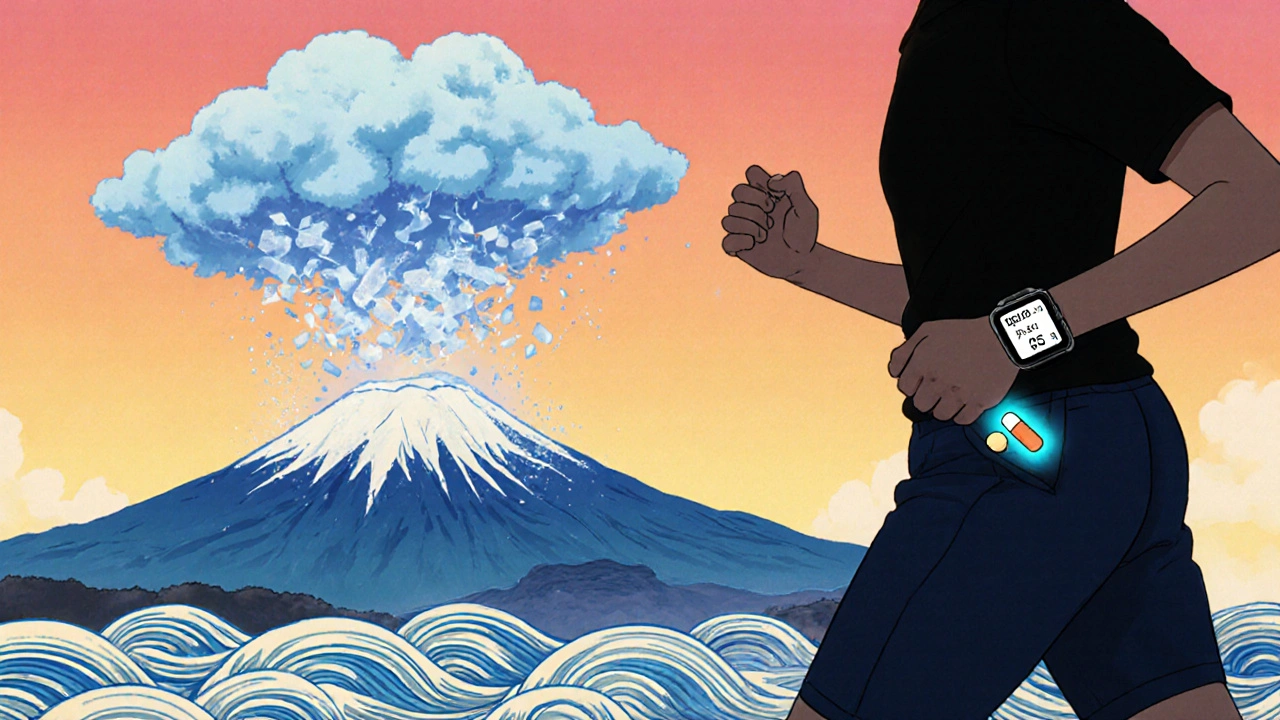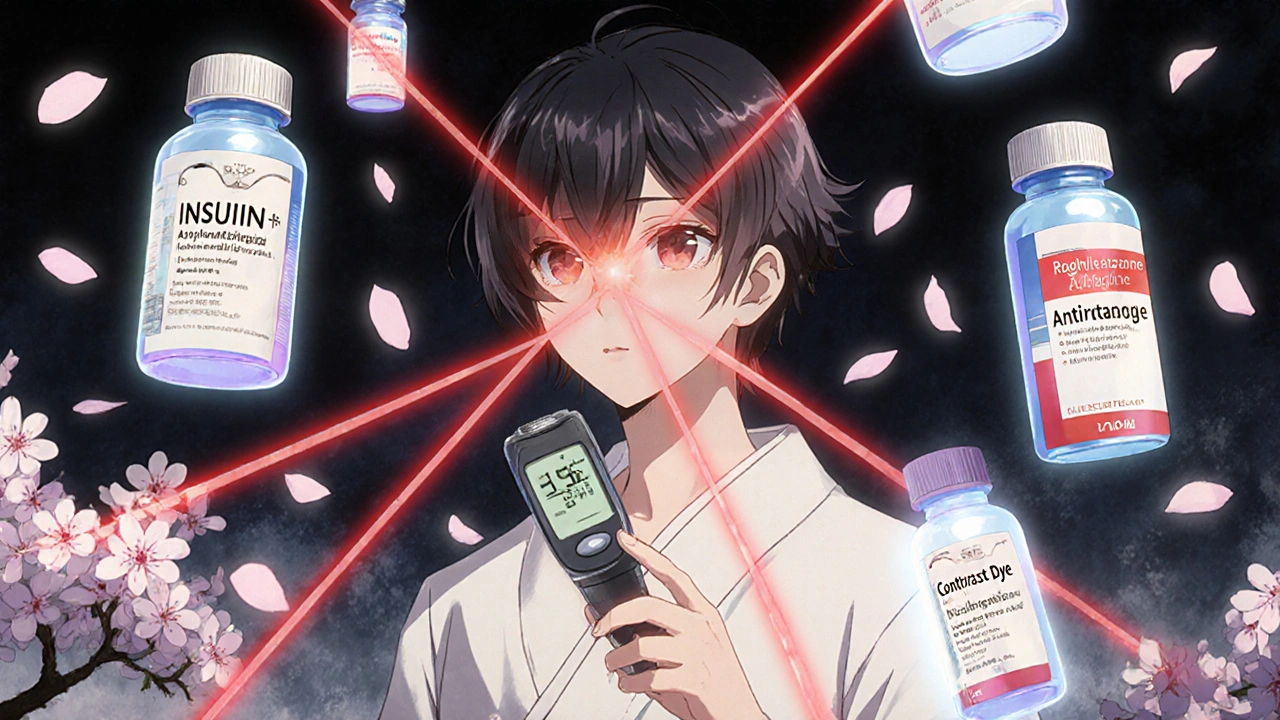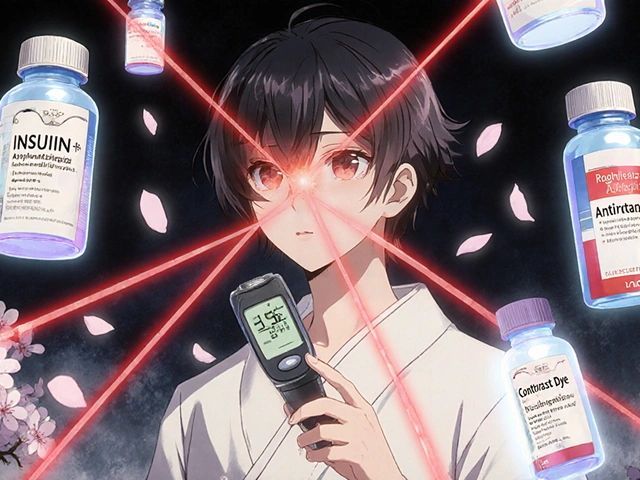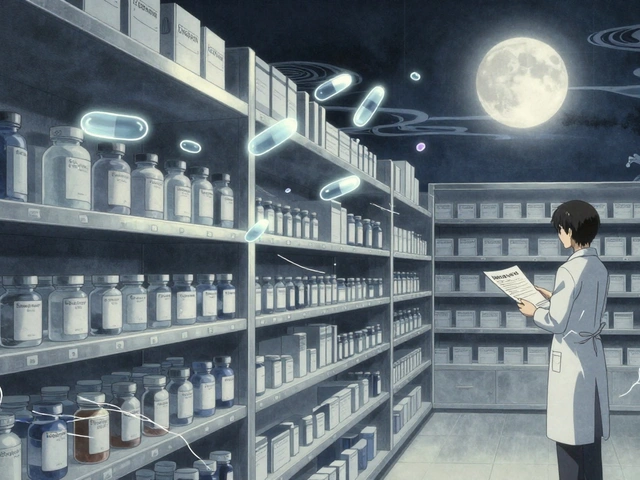Diabetes Medication Interaction Checker
Check Your Medication Safety
Enter your diabetes medication and any other drugs or supplements you're taking to see if there are dangerous interactions.
When you're managing diabetes, taking the right meds at the right dose is only half the battle. The other half? Knowing what happens when those meds meet other drugs you’re taking-whether it’s for high blood pressure, infection, or even a common cold. Some combinations can send your blood sugar crashing, others can make it spike dangerously high. And many people don’t realize they’re at risk until it’s too late.
Why Diabetes Medication Interactions Matter
Diabetes isn’t just about insulin or metformin. Most people with type 2 diabetes end up on two or more medications over time. Add in antibiotics, painkillers, heart meds, or even over-the-counter supplements, and you’ve got a cocktail that can mess with your glucose control in ways you won’t see coming.
The body processes these drugs through liver enzymes like CYP3A4, CYP2C8, and CYP2C9. When one drug blocks or speeds up these enzymes, it changes how fast another drug gets broken down. That means your diabetes med might stay in your system too long-or vanish too fast. The result? Hypoglycemia or hyperglycemia. Neither is safe.
High-Risk Combinations You Need to Watch
Some drug pairs are outright dangerous. Here are the top ones doctors warn about:
- Insulin + Rosiglitazone: This combo increases fluid retention and can trigger heart failure. Rosiglitazone isn’t used much anymore, but if you’re still on it, don’t add insulin without close monitoring.
- Meglitinides (repaglinide, nateglinide) + Azole Antifungals (ketoconazole, itraconazole): These antifungals block the liver enzymes that clear repaglinide. Blood sugar can drop so low you’ll need emergency treatment. Even common antibiotics like clarithromycin can do this.
- Metformin + Contrast Dye (for CT scans): The dye can harm your kidneys, and metformin builds up if your kidneys slow down. That raises your risk of lactic acidosis-a rare but life-threatening condition. Always tell your doctor you’re on metformin before any imaging test.
- Sulfonylureas (glyburide, glipizide) + Quinine: Quinine, found in some malaria meds and tonic water, can cause severe hypoglycemia. It’s not just prescription drugs-tonic water in cocktails can be enough to trigger a drop in sensitive people.
There’s also something you might not expect: somatostatin analogues like octreotide. Used for certain tumors or severe diarrhea, they can cause blood sugar to swing both ways-first low, then high. It’s unpredictable, and if you’re on one, you need daily glucose checks.
What’s Safer? Newer Diabetes Drugs
The good news? The newer classes of diabetes meds are much less likely to cause bad interactions.
GLP-1 receptor agonists (like semaglutide, liraglutide) and SGLT-2 inhibitors (like empagliflozin, dapagliflozin) work differently. They don’t rely on liver enzymes the same way older drugs do. That makes them safer to combine with other medications.
In fact, the American Diabetes Association now recommends combining GLP-1 RAs with insulin-not just for better blood sugar control, but because it lowers the risk of hypoglycemia compared to insulin alone. That’s a big shift from just a few years ago.
And here’s something clear-cut: don’t combine DPP-4 inhibitors (like sitagliptin) with GLP-1 RAs. They do the same thing. It’s like taking two identical painkillers-no extra benefit, just more side effects like nausea or pancreatitis risk.

Hidden Triggers: Non-Diabetes Meds That Affect Blood Sugar
You might not think of these as diabetes drugs, but they can wreck your control:
- Corticosteroids (prednisone, dexamethasone): Even a short course can make your blood sugar soar. If you’re on steroids, you may need to increase your insulin or oral meds temporarily.
- Thiazide diuretics (hydrochlorothiazide): These are common for high blood pressure, but they can raise blood sugar over time. If you’re on one and your levels are climbing, talk to your doctor about switching to a different class.
- Statins (atorvastatin, rosuvastatin): High doses may slightly raise blood sugar. The heart benefits usually outweigh the risk, but monitor closely if you’re already struggling with control.
- Beta-blockers (metoprolol, propranolol): These can mask the symptoms of low blood sugar-like shaking or a fast heartbeat. You might not realize you’re hypoglycemic until you’re confused or fainting.
What to Do: A Simple Safety Plan
You don’t need to memorize every interaction. But you do need a system:
- Keep a full list of every medication, supplement, and herb you take. Include over-the-counter stuff and vitamins. Bring it to every appointment.
- Ask your pharmacist every time you pick up a new prescription. They’re trained to spot interactions and often catch things doctors miss.
- Check your blood sugar more often when starting a new drug-especially antibiotics, steroids, or pain meds. Track it for at least a week.
- Know your warning signs. Shaking, sweating, dizziness? That’s low. Thirst, frequent urination, blurry vision? That’s high. Don’t ignore them.
- Don’t self-medicate. Even something as simple as turmeric or garlic supplements can affect how your diabetes drugs work. Tell your doctor before trying anything new.

What About Alcohol and Diet?
Alcohol can cause hypoglycemia, especially if you’re on sulfonylureas or insulin. It blocks the liver from releasing glucose. One drink might be okay if you’ve eaten, but two or three? That’s risky.
And don’t forget about grapefruit. It blocks CYP3A4-the same enzyme that breaks down repaglinide. Eating grapefruit or drinking juice while on this med can lead to dangerous lows. Same goes for Seville oranges and pomelos.
When to Call Your Doctor Immediately
Call your healthcare team if:
- Your blood sugar drops below 4.0 mmol/L and doesn’t rise after treating it
- You’re having repeated highs (above 15 mmol/L) for more than two days
- You feel unusually tired, confused, or short of breath after starting a new drug
- You’re scheduled for surgery or a scan with contrast dye
These aren’t normal side effects. They’re red flags.
Final Thought: You’re the Best Monitor
Your doctor can’t be with you 24/7. But your glucose meter can. If you’re on multiple medications, daily tracking isn’t optional-it’s your safety net. Keep a log. Notice patterns. If your sugar dips after taking a new antibiotic, write it down. Bring it to your next visit.
Diabetes management is a team sport. But you’re the captain. The more you know about what your meds do-alone and together-the safer you’ll be.
Can I take metformin with antibiotics?
Most antibiotics are safe with metformin, but some-like ciprofloxacin or trimethoprim-can increase the risk of lactic acidosis, especially if you have kidney issues. Always check with your pharmacist before starting a new antibiotic. If you’re feeling unusually tired or have muscle pain, stop the antibiotic and call your doctor.
Is it safe to combine insulin and GLP-1 RAs?
Yes, and it’s often recommended. Combining insulin with a GLP-1 RA like semaglutide improves blood sugar control better than insulin alone, while lowering the risk of low blood sugar and weight gain. Many people find they need less insulin when using both. Always start low and adjust slowly under medical supervision.
Why should I avoid grapefruit with diabetes meds?
Grapefruit blocks the CYP3A4 enzyme in your liver, which is how your body clears certain diabetes drugs like repaglinide. This causes the drug to stay in your system longer, increasing the risk of severe hypoglycemia. Even a small glass of juice can trigger this. Avoid grapefruit, Seville oranges, and pomelos completely if you’re on these meds.
Do diabetes meds interact with herbal supplements?
Yes. Supplements like bitter melon, fenugreek, and cinnamon can lower blood sugar on their own. When taken with metformin or sulfonylureas, they can push your levels too low. Even St. John’s Wort can interfere with how your liver processes some diabetes drugs. Always tell your doctor what supplements you’re taking-even if you think they’re "natural" and harmless.
What should I do before surgery?
Always tell your surgeon and anesthesiologist you have diabetes and what meds you take. You may need to stop metformin 48 hours before surgery if contrast dye will be used. Insulin doses often need adjustment during fasting. Your diabetes team should guide you on when to hold or change meds before any procedure.








Reema Al-Zaheri
November 20, 2025 AT 06:49Metformin and contrast dye interactions are under-discussed, but critically important. I’ve seen patients admitted for lactic acidosis after CT scans because they weren’t told to hold metformin. It’s not just about kidney function-it’s about timing, documentation, and clear communication between radiology and primary care. Always confirm the protocol with your endocrinologist before any imaging.
Michael Salmon
November 21, 2025 AT 18:30Stop pretending these drug interactions are some secret conspiracy. If you can’t read a drug label or ask your pharmacist, maybe you shouldn’t be managing your own meds. This post is just fear-mongering dressed up as education. People die from ignoring basic medical advice-not because of interactions, but because they’re lazy.
Joe Durham
November 22, 2025 AT 16:35I appreciate the depth here. As someone who’s been on metformin and then added a GLP-1 RA, the shift in my daily life was huge. Less hypoglycemia, more stable energy, and honestly, fewer panic checks on my CGM. The key isn’t just avoiding bad combos-it’s knowing what good ones look like. This post nails that balance.
Derron Vanderpoel
November 24, 2025 AT 04:02Okay so I just started semaglutide last week and I swear I thought I was dying from the nausea-like, full-on sweating, dizzy, almost passed out-but then I realized it was just my body adjusting. And then I remembered-oh right-this is why you start LOW. Like, super low. My doc gave me 0.25mg and I was like ‘is this a joke?’ Turns out it’s genius. Also, grapefruit juice? I threw out my whole damn fridge. No regrets.
Timothy Reed
November 24, 2025 AT 07:16One of the most practical and well-structured summaries I’ve seen on this topic. The five-point safety plan is especially valuable-it’s actionable, clear, and doesn’t overwhelm. Many patients don’t realize pharmacists are trained specifically to catch these interactions. Make that relationship a priority. Also, tracking blood sugar during new med starts isn’t optional-it’s the difference between adaptation and crisis.
Christopher K
November 25, 2025 AT 10:10Oh great, another American medical industry scare tactic. In my country, we just take our meds and trust the system. Why are we being told to fear every antibiotic, every steroid, every damn grapefruit? This isn’t medicine-it’s marketing. If you’re scared of your own prescriptions, maybe you shouldn’t be on them.
harenee hanapi
November 25, 2025 AT 17:01I’ve been on glyburide for 12 years and I swear I’ve never had a problem… until I drank one glass of tonic water at my cousin’s wedding. I collapsed. Literally. They had to give me IV glucose. And now? I can’t even look at a lime without crying. My whole life is ruined. I’m just so tired. Nobody understands.
Christopher Robinson
November 27, 2025 AT 02:49Big thumbs up 🙌 for the GLP-1 + insulin combo point. I was skeptical at first, but now I’m on semaglutide + basal insulin and my A1c dropped from 8.4 to 6.8 without a single low. Also-yes, grapefruit is a no-go. I used to drink it every morning. Now I drink water. And I’m not even mad about it. 🥤
James Ó Nuanáin
November 29, 2025 AT 00:00It is, indeed, a matter of grave concern that such critical pharmacological interactions are not universally standardized across healthcare jurisdictions. The United Kingdom, for instance, maintains rigorous guidelines regarding CYP450 enzyme inhibition and its implications for diabetic pharmacotherapy. One must question the adequacy of public health dissemination when laypersons are left to navigate these complexities alone.
Nick Lesieur
November 30, 2025 AT 08:37lol at the ‘don’t self-medicate’ advice. Like anyone’s gonna stop taking turmeric because some blog says so? I take 3 pills a day of ‘natural’ stuff and my sugar’s better than my doctor’s. Also, metformin and antibiotics? Pfft. I take cipro all the time. My kidneys are fine. Stop scaring people.
Angela Gutschwager
December 2, 2025 AT 03:08Don’t take grapefruit. Ever. Just don’t.
Andy Feltus
December 3, 2025 AT 01:07It’s funny how we treat diabetes like it’s a puzzle to be solved with perfect compliance. But what if your life doesn’t allow for perfect tracking? What if you work two jobs, can’t afford the CGM, and your doctor only sees you every six months? This post is great-but it assumes privilege. The real danger isn’t the drug combo. It’s the system that leaves people guessing.
Dion Hetemi
December 4, 2025 AT 11:44Wait, so you’re telling me I’ve been risking lactic acidosis every time I get a sinus infection? I’ve taken cipro like 5 times. My kidneys are fine, but maybe I should’ve been dead by now? This is terrifying. I’m going to the ER tomorrow just in case. I’ve got a headache and I think I’m dying.
Kara Binning
December 5, 2025 AT 09:16After my dad died from a diabetic crisis after a steroid shot, I don’t trust ANY doctor. Not even the ones who say ‘it’s safe.’ I’ve stopped all meds. I’m doing keto, fasting, and prayer. My sugar’s fine. The system failed us. And now I’m not letting it take anyone else.
river weiss
December 6, 2025 AT 22:34The CYP enzyme interactions are indeed critical, particularly in polypharmacy scenarios common among elderly diabetic populations. However, it is equally important to emphasize that patient education must be iterative, not one-time. Pharmacists, nurses, and community health workers play a pivotal role in reinforcing these points-especially when language barriers, health literacy, or cognitive decline are present. The burden should not rest solely on the patient to memorize every interaction.